A GOLD VESTA, 1907
Leo de Rothschild (1845-1917) and Carl Meyer (1851-1922)
Sorting through my parents’ effects after my mother’s death in January 2006, I found a small gold vesta personalized with a cypher formed of the letters CM inset with diamonds beneath the inscription ‘KIMBERLEY’ and above the date ‘1907’. On the reverse is the cypher LR enamelled in blue and yellow beneath the inscription ‘SHORTGROVE’. This was preserved in its original leather box with the name of the retailer ‘Catchpole and Williams, Oxford Street’, printed on the upper silk lining.
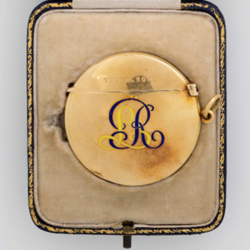
Verso: Vesta, gold, inlaid with Leo’s initials enamelled in Rothschild racing colours, 1907
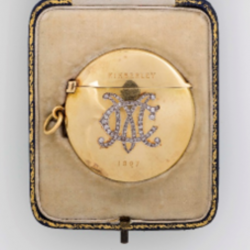
Recto: Vesta, gold, inlaid with diamonds with Carl Meyer’s initials and engraved ‘Kimberley’ and ‘1907’ Catchpole and Williams, Oxford Street.
My great grandfather Sir Carl Meyer, 1st baronet, came from Hamburg to London to work for Rothschilds in 1871 and remained with them for twenty-five years. He was known affectionately as the ‘ever industrious CM’ and the vesta was a gift to him from Leo de Rothschild, testament to their long friendship and shared interests in horseracing.
The vesta is also inscribed Kimberley, signifying the diamonds discovered there in the Northern Cape, South Africa, in 1871. Kimberley had special associations for Carl Meyer; the family letters demonstrate that it was Carl who introduced Cecil Rhodes to the London-based Rothschild bank in 1888 who then put up the necessary capital to finance De Beers Consolidated Mines. That same year Carl Meyer was appointed a Director of De Beers and this was the single most significant engagement of his business life. From 1898, he was established as a Director of the National Bank of Egypt, in close association with Ernest Cassel (1852-1921), the eminent financier, a long-standing family friend, resident of Newmarket and patron racing.
Leopold de Rothschild
When Carl joined N M Rothschild as an interpreter in the 1870s, the partners were three Rothschild brothers Nathaniel, Leo and Alfred. While Nathaniel had represented Aylesbury in Parliament from 1865; Alfred was made a Director of the Bank of England in 1868 but Leo’s interests were dominated by horse racing. In 1879 Leo was the owner of the Derby winner Sir Bevys; his horse St Fresquin came second to the Prince of Wales’s Persimmon at the Derby in 1896 and Leo won again in 1904 with St Amant, a St Fresquin colt. This pre-occupation was not to change – on 18 April 1888 Carl wrote to his wife, Adèle: “Lord R. in good spirits, presented me with 100 bottles of champagne to-day. Wonders will never cease. Alfred fussy, Leo racing at Newmarket, had the Prince of Wales to dinner last night, but cannot win a race to pay for the expenses.”
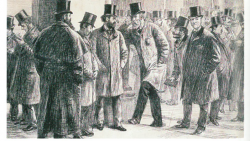
‘A Scene on ‘Change’. Carl Meyer is the diminutive figure looking down with the 1st Lord Rothschild with his back to the pillar on the left and his son Walter to the right The Graphic 9 May 1891
The letters LR on the vesta are enamelled in the Rothschild racing colours, L in yellow and R in blue. Leo had registered his personal racing colours in 1879, but his uncle Mayer de Rothschild had registered the same colours thirty-six years earlier; Leo was elected to the prestigious Jockey Club in 1891. In 38 years of racing Leo won an estimated 851 races.
A silver cigarette lighter enamelled with Rothschild racing colours inscribed ‘St Amant 1904 LR’ which Leo gave the jockey Kempton Cannon who rode St Amant to victory in the Derby despite a tumultuous thunderstorm is in the collection of NHRM. The prestigious Russian jeweller, Carl Fabergé, established a branch in Dover Street, London in 1906, and tailored his work to appeal to the Rothschilds by enamelling fashionable accessories with their blue and yellow racing colours. His London colleague, Henry Bainbridge cabled Fabergé in St Petersburg, ‘Everything that has been made before now make in the Rothschild colours’. Fabergé then produced a range of pieces including, to Bainbridge’s astonishment, a motor mascot formed as a bird with ‘large diamond eyes’ and wings that flapped when the car moved. Leo de Rothschild succumbed as he was as keen on motoring as horse racing and succeeded in increasing the motoring speed limit to 6 miles an hour in 1902.
Most of the Fabergé pieces enamelled in their racing colours were acquired by the Rothschilds as gifts for others. Leo bought the earliest examples; a pair of candlesticks, a matchbox and a bonbonnière on 7 December 1909; the range remained in production until 1913. Bainbridge noted that they were kept to hand so that, ‘Whenever he wanted to say ‘Good morning!’ ‘I like you!’ or ‘Don’t bother me anymore!’ he simply slipped a dark blue and yellow Fabergé object into his friend’s pocket.’ The Rothschilds used to give the drivers of the buses on the Mansion House and Bank of England route a brace of pheasant before Christmas and insist that their whips were adorned with Rothschild racing colours.
Shortgrove
Above Leo’s initials, ‘SHORTGROVE’ refers to the sporting estate near Newport, Essex, with its Neo-Palladian house extended by architect Matthew Brettingham, which my great grandparents bought in 1903 and lived with their son Frank, known as ‘Boy’ and their daughter Elsie.
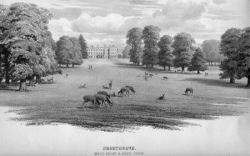
Shortgrove, Newport, Essex 1903
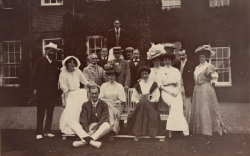
Family house party at Shortgrove, 1907 from albums compiled by Elsie Meyer shows Carl holding a cigar and other guests with cigarettes in their mouths.
The proximity of Shortgrove to Newmarket was an incentive for the Meyers’ purchase of the property. They hosted regular house parties for the Newmarket Summer Meetings; 1904, 1905, 1907, 1908, 1909. In 1902, Carl had registered his racing colours ‘gold, silver and copper’ (presumably referencing his occupation as a banker) and bought his first racehorse Carbineham – inspected on 27 August 1902: “I am going down to Royston early to-morrow morning to look at the gee but shall be back in City at lunch time.” The next day he reported: ‘The gee was very well but is not big enough to win races yet’.
On 2 September 1902 Carl ‘lunched at New Court with Lord R and Leo, just back and need not tell you that Carbineham’s exhibition afforded ample material for chaff.’ On 16 September 1902 ‘Tell Boy Carbineham seems to have been 10th out of 13 that is what the trainer calls ‘he ran well’. Carl’s impatience with his latest horse is expressed in his transliteration of the name; Carbineham becomes Krummbinehax. Thus on 29 September 1902 Carl writes to his wife ‘I intend going to Newmarket tomorrow for the day to see Krummbinehax run but have no hope whatever of his winning.’
Frank Meyer, was also a racing enthusiast and wrote to his mother from Eton on 19 July 1903 with a racing tip: “Tell dad that Kronstat is worth support for the Knowsley Dinner Stakes (Thursday) and Intelligence for the St George Stakes (win & place) on Friday. Both at Liverpool. PS Remind Dad to back Kronstadt to=morrow and Intelligence today
By August 1903 Carl’s horse Porcelain occupied his usual place in the rear – no good. In October that year Carl reported from Shortgrove to Adele who was staying at the Ritz in Paris
My run to Newmarket took 55 minutes and was very pleasant. I met no end of friends of both sexes, there were a great many pretty women to-day and quite a number of my favourites. I spoke to the Cassel contingent who return to Town tomorrow and to numerous others. The king appeared to be in very good spirits. Apart from the middle Pars Plate which Pretty Polly won in a canter the racing was not of a very high character but it was a lovely day. I was back before 5.”
Sylvia Thompson, Adèle’s niece remembered that at Shortgrove:
“all the grown-up people staying at the house always seemed to want to go to Newmarket. Going there excited them. They slung race glasses in leather cases over one shoulder. At departure everyone talked noisily and buzzingly in the hall until the cars drew up, and then, with even more eagerness, when they came back after tea. They used to come out from the house, in the mellow evening light on the lawn. When my uncle sat down to a belated tea in the Japanese tent that was set under an immense laburnum tree on the edge of the lawn, he would say ‘I saw so-and-so and so-and-so’ to interest my Aunt Adele who was bored by racing but not by lists of people’s names.”
In 1905 Carl changed his racing colours to emerald, green, violet sleeves and cap, significantly these were the Suffragette colours whose cause his wife Adèle espoused. A cigarette playing card, dated 1914, a Jack of Hearts, shows the colours worn by celebrated jockey Herbert Robbins (1887-1927). This is part of a series ‘Jockeys and Owners’ Colours with Playing Cards inset’, one was published by Wills as a Scissors Set. The other set was published by British American Tobacco (the export company of Imperial Tobacco, who owned Wills). Herbert Robbins is recorded as riding Carl’s horse Militant in 1913; they finished almost last.
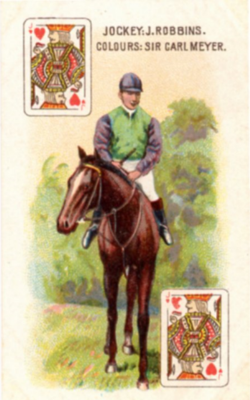
Cigarette playing card, 1914, showing the celebrated jockey Herbert Robbins (1887-1927) wearing Carl Meyer’s racing colours. Part of ‘Jockeys and Owners’ Colours with Playing Cards inset’, published by Wills as a Scissors Set.
Carl’s winnings between 1902 and 1923 totalled £15,400 from 46 races (Ruffs Guide to the Turf). His most successful year was 1911 when he won £3419, followed by 1909 when he made £2492. The winnings in 1911 included the Northumberland Plate at Gosforth Park, Newcastle with Glenesky (born in 1906). The silver-gilt racing cup was bequeathed by Adèle to Frank in 1930. In the 1910s Carl hosted an annual house party for the St Leger at Doncaster but in September 1914, this was cancelled due to the outbreak of war. The Times on 5 September reported that Sir Carl has placed his London house, 10 Stratton Street, Piccadilly ‘at the disposal of the war authorities for the German prisoners now in London’.
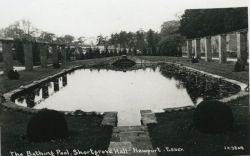
The Bathing Pool, Shortgrove, Newport, Essex with glass houses in the background
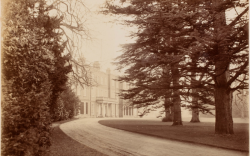
Shortgrove, 1903 from the albums compiled by Elsie, daughter of Carl Meyer
In 2014 I spoke to the Newport Local History Society about my great-grandparents twenty years at Shortgrove. I was shown a betting purse in the Rothschild racing colours with Carl’s initials in the Newport Local History Collection; another gift from Leo later presented by Carl to his head gardener, Edmund Guile, in 1912. He previously served as under gardener at Leo de Rothschild’s country home Ascott, near Leighton Buzzard, where he had cultivated carnations. I was delighted to discover Guile’s granddaughter was in the audience. She brought with her some articles about him from his family archive and a photograph of her grandfather.
Carl Meyer and Leo de Rothschild were colleagues and friends for forty-five years. It was therefore a great pleasure to agree in 2021/22 to the allocation of the gold vesta as a Cultural Gift to the Newmarket National Horse Racing Museum, opened by Her Majesty the Queen in November 2016, where it is shown alongside Carl’s racing purse in the Rothschild colours, generously lent by the Newport local history society. Both gifts bear witness to a lifelong friendship.
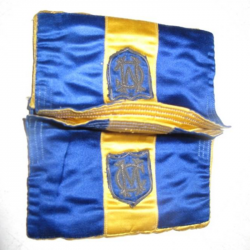
Carl Meyer’s Betting Purse in Rothschild Racing Colours: Newport Local History Society on loan to the National Horseracing Museum at Palace House
Written by Tessa Murdoch
